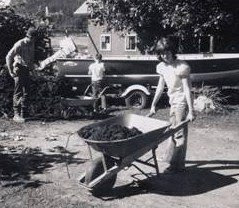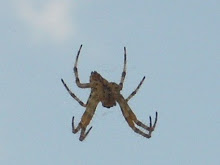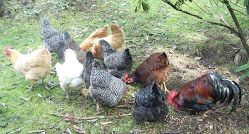 Today I planted potatoes in between the raindrops, which got me started thinking about potatoes and what I know about them.
Today I planted potatoes in between the raindrops, which got me started thinking about potatoes and what I know about them.Potatoes were the only thing I planted in my very first garden when I was probably ten or so. Mom had heard about a new method which we tried. We had an old wooden boat in the back yard that made a perfect south facing backdrop for my new garden. Beside it we put a layer of hay on top of the grass, then a little dirt, some old potatoes from the grocery store that had sprouted in the potato drawer and more dirt to cover them. I vividly remember planting and watching, I don’t remember if I got any potatoes, but I am sure I did. I planted a few potatoes there every year slowly adding other things until eventually it was just a flower garden. My mom is still using parts of that old garden and I still enjoy growing potatoes.
Potatoes are great to grow because they are easy, don’t take much care and if conditions are right can really produce. But there are some things to consider before you get started with your potato adventure.
The place to plant: Potatoes are the most productive if they are in the sun and in rich soil, although they will grow almost anywhere. They need some space 8-12 inches between each plant and 8 – 10” total depth of soil. Adding compost under and around will enhance any potato garden. Potatoes are considered a cool weather crop, so plant early and in an area where you can plant something else when they are done.
Type of potato: For everyday eating the standard Idaho Russet variety of potato that you buy at the grocery are not expensive and they taste fine. So I just buy them…they are ready to eat and it is not a bad thing to contribute to Idaho’s economy or where ever they are grown. I save my precious garden space for special potatoes…
You might think that the varieties you buy at the grocery are the very best and you have the space so you decide to plant that kind. Be aware that generally potatoes found in the produce section have been treated with some kind of sprout inhibitor (a healthier reason to grow your own) which means they will probably grow eventually but it might take all season before they start. For gardening buy “seed” potatoes at the greenhouse store. “Seed” just means they are specially selected for growing in gardens and have no treatment, but they are potatoes. Nurseries will have russets and many more varieties.
Special potatoes: You should do some experimenting to find out which potatoes you think are special. I love the finger (small, long and skinny and look like fingers) and Golden potatoes (this attraction might be psychological since they look like they already have butter on them). Above I mention sprout inhibitor, but these two potatoes at Costco seem to be the exception (I discovered by accident) so that is where I get them. Another favorite is Yukon Gold that I get at the nursery.
Planting and care: There are many ways to grow potatoes; research on the internet will give more choices than are possible. When selecting your seed potatoes choose small ones, it is better to keep them whole when planting. Growing up we always cut chunks that included several “eyes” (sprouts) but this can invite problems that will cause the piece to rot and not grow. I just bury the whole thing in my raised bed with a little new compost under and dirt on top. The important thing is regular water and enough growing medium to keep the potatoes covered.
Potato problems: Scab is a common ailment found on the skin of home grown potatoes. It looks just like what the name implies and commercially they probably have a spray to prevent it. It doesn’t look all that great but won’t hurt you and can easily be peeled away. Scab is more common when potatoes are planted in the same place year after year. Rotating all garden crops at least three years is always good. I did read that keeping the soil on the acidic side is important so don’t add lime to your potato garden. Also buy seed that is scab resistant.
If a potato grows above the surface of the dirt it turns green and the green part tastes terrible. You can cut off the green and use the rest, but to prevent this, cover potatoes as you see them appear.
Harvesting: What I have always known is that when the plant turns brown and falls over, it is time to dig. It is so fun to discover the potato treasures after taking care of them for so long. Potatoes should be stored in a cool dark place and can last all winter. In the last few years I made an amazing discovery…potato plants don’t mind being stolen from. As soon as the plants are close to full grown, I gently dig and pick one or two potatoes from a plant which are connected with a long white root. The young tender potatoes don’t have much skin so a good scrub under the faucet makes them ready for boiling, baking or even better, grilling with a little olive oil and some fresh herbs.
In the Northwest, potatoes are all done and ready to harvest by early August. This gives a great opportunity to plant another cool weather crop you enjoy throughout the fall, such as leaf lettuce, spinach, broccoli, etc. I have also planted annual flowers in my potato bed since by then garden stores have them on sale.
Keeping your own seed potatoes: At the end of the season when I have gathered all the potatoes to eat and/or store there are always a bunch of small ones that are just a pain in the neck to deal with. I store them unwashed in the fridge’s veggie drawer to use as seed potatoes the next year.














This post made me giggle! My best bud has been asking all kids of q's about how to grow potatoes. So when I stumbles upon this I was thrilled to send her your link! Not only that but we are wester washington gals too!! This is a great blog I can't wait to read more!! Thanks!
ReplyDelete